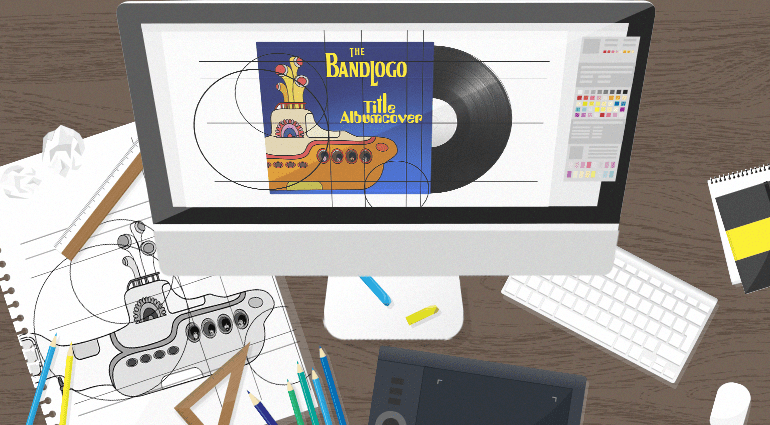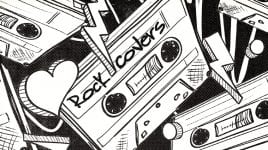
Ironically, when we stream or buy a music album, the first impression is a visual one: Even before we hear the first note, the album cover is visible. It is all the more important for artists and producers to devote the necessary attention to the design of the cover with time and patience. After all, the goal is to bring the direct – or hidden – message of the entire album into one square image. ?
Birth of the printed album cover
The optical staging of album covers, which we take for granted these days, goes back to the 1930s. Records were offered and sold without a printed cover up to that point, but a certain Alex Steinweiss came up with a clever and effective idea. The graphic designer worked as art director for Columbia Records and found the simple sleeves to be monotonous and unappealing. He became the inventor of the printed record sleeve and father of album art design. He gave the square covers a new “jacket” and influenced the music industry to this day through his artistic approach.

Photo-realistic composition and art design by Hipgnosis
The British design company Hipgnosis, took Steinweiss’ idea to the next level and became major international trendsetters in album art design. Across genres and styles, elements of surrealism, Dali, Duchamp, Buñuel and numerous other influences flowed into the designs. The design legends began in collaboration with Pink Floyd, after which they became more and more popular. Hipgnosis’ works illustrate hundreds of the most famous albums in the world. Their 50th anniversary is now being celebrated with exhibitions:
You are currently viewing a placeholder content from Vimeo. To access the actual content, click the button below. Please note that doing so will share data with third-party providers.
Capturing the Zeitgeist in an album cover
The art and designer scene agrees that a cover must have something to say against the background of the respective zeitgeist (the spirit of the current era). Provocative motifs, photos and collages can promote sales. Likewise, its effectiveness can be supported by designs with a large scope for interpretation for the public. Those who choose this path make use of the possibilities and creative freedom of the fine arts, such as Andy Warhol, when he combined the then-burgeoning concepts of commercialisation, mass production and celebrity stardom with his pop art movement:

Portraits for a more personal connection
On the other hand, there is often more identification with the artist through portrait photos. The fans get an impression of the artist’s gestures, facial expressions, fashion sense and aesthetics, which can promote a sense of sympathy and identification for the listener or potential buyer. Not to mention its effect of quicker recognition of an artist or band than a “nameless” graphic, pretty important given the constant influx of new albums on the market.
Must be informative! Or not…
An important element is, of course, the title of the album. However, newcomer artists or bands often don’t give their debut album a title, this is commonly known as a “self-titled” album. It can be a useful strategy to gain recognition from the audience and to make the band or the artist known to the public, at the same time to establish it as an independent brand. Therefore it is by no means imperative to have the band, artist or album name (or logo) on the front cover of an album. But on the contrary:
Epic cover art to go down in history
If the above is done, it usually gives the designer more creative freedom because there is no need to compromise the images for text positioning. On the front, text-free covers are used more frequently by well-known bands and international stars who have long since established themselves as an independent brand among their fans. The advantage: if the motif and the idea work, the cover can make it to the Olympus of album design history.
Dealing with the emotions of the viewer
Usually, for musicians and their artistic teams, there are several designs to choose from. Which one they ultimately choose is sometimes arbitrary but also might, blatantly or subconsciously, be chosen to help attract potential buyers. Take, for example, the album “Boston” by the band of the same name from 1976. The cover depicts a scene with guitar-shaped spaceships. Guitarist and songwriter Tom Scholz, Epic Records and manager Jim Charney decided that the spaceship armada should not attack the Earth, but should instead protect it. The cover art design is in harmony with the science fiction feeling of this album and should go down in history.
The elements on “Wish You Were Here” by Pink Floyd
Another example of expressive visualisation, with scope for interpretation, is the album cover of Pink Floyd‘s “Wish You Were Here“: In the photo, two stuntmen shake hands; one of the two is on fire from head to toe. The shocking part is that the picture was never retouched, the man was really on fire during the photo shoot. The four elements fire, water, air and earth were to be symbolised on the cover, which was implemented by numerous well-planned design details, including a logo placed in the bottom right corner (as well as on the plastic packaging for the vinyl record). Photo shoots like this, in the ’60s cost thousands of dollars, an effort that isn’t often made these days due to inexpensive digital image processing.
- the front cover
- the plastic wrapping design
2 comments
Leave a Reply
You are currently viewing a placeholder content from Facebook. To access the actual content, click the button below. Please note that doing so will share data with third-party providers.
More InformationYou are currently viewing a placeholder content from Instagram. To access the actual content, click the button below. Please note that doing so will share data with third-party providers.
More InformationYou are currently viewing a placeholder content from X. To access the actual content, click the button below. Please note that doing so will share data with third-party providers.
More Information





















logo design services says:
A cover art designer is a type of graphic designer who creates artwork for music-related projects. I specialise in logo design services. Graphic designers that create cover art and liner notes frequently dabble in the design of posters, T-shirts, and other products for musicians and record labels.
https://webdesignbolt.com/services/logo-design says:
It will take time and effort to discover your own style, so do everything you can to gain as much knowledge as possible. I am a professional in logo design services. Take an art lesson, travel, and doodle in your sketchbook while watching tutorials. Examine the work of artists whose work you admire. Read books and pay attention to the many styles and mediums used.